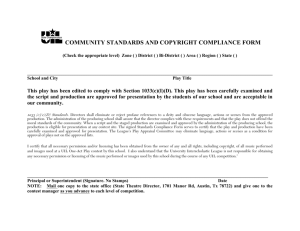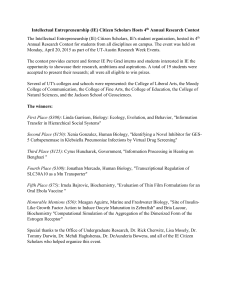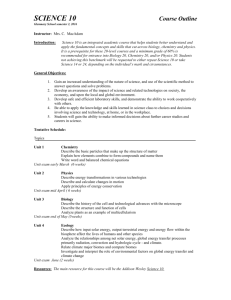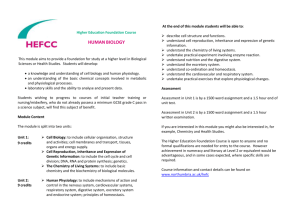Introduction to the UIL Science Contest 2015-2016
advertisement
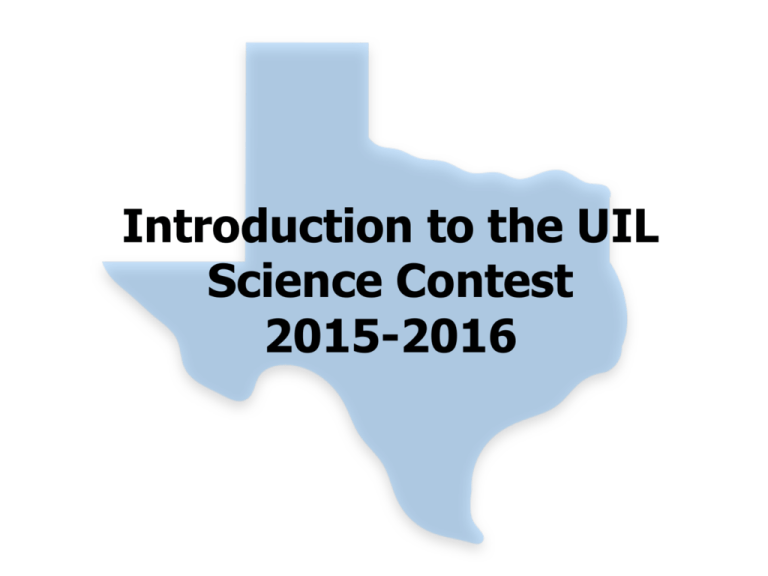
Introduction to the UIL Science Contest 2015-2016 U Science Directors • Dr. Debra Hansen Biology • Dr. Paul McCord Chemistry anyone?... • Dr. David Bixler Physics Purpose of UIL Exams • to challenge students in the basic fundamental principles of science • to promote learning in biology, chemistry, and physics • to foster a sense of enthusiasm about advanced topics and courses in the sciences • to help prepare students for the rigor of college level courses The Science Contest • Biology, Chemistry & Physics are all combined on one exam, and is both an individual and a team compe<<on. • The contest helps to promote a broad base of knowledge and beAer understanding. • The contest models degree requirements at most Universi<es. • Many current areas of research are in interdisciplinary fields. Contest Structure • 60 Multiple Choice Questions, which are divided into 20 of each topic: Biology, Chemistry & Physics. • Contestants are given 6 pts. for a correct answer, 0 pts. for unanswered questions, and lose 2 pts. for incorrect answers. • The best possible answer is the correct answer. Few Details… • At the state competition only, there is no limit on the number of answer choices given on a question, e.g. A through J, not just up to five answer options A through E. • There is no restriction that numeric wrong answers must differ by ±5% • Work the problem accurately and pick the best answer choice. • If you work the problem correctly, the choice will be there with no ambiguity. Academic Meets • Invitational Meets A & B (practice - not governed by UIL) in January & February • District Meets 1st week & 2nd week usually during March • Regional Meet usually during April • State Meet usually during May Advancement/Qualification • Are done by division (1A-6A) and each HS may enter 6 contestants at their district meet, where a minimum of 3 contestants constitutes a team. • 1st, 2nd & 3rd place overall scorers • Top score in each subject area • Top 4 member team by combined score • Plus one alternate in each category Things to keep in mind … • The contest is difficult! • However, the top scores at the State Contest will be nearly perfect in each subject. • There needs to be a clear cut winner and this will require a selection of difficult questions on the contest. • All schools divisions 1A – 6A compete with the same contest, but the scores are only compared with schools in the same division. • But there are benefits for all of that effort spent in preparing for the contest… Some Contest Rules • Contestants have up to 2 hours, but must remain for at least 30 minutes. • You may use additional scratch paper provided by the contest director. • Calculators (not computers) without built in or stored scientific information are allowed, but the memory must be cleared before the beginning of the contest. Biology Texts (10th ed recommended) Biology, 9th edition, Campbell, et. al. is okay Recommended Online Biology Resources: • University of Texas Bio 311C site: http://bio311.biosci.utexas.edu/ • Learn Genetics University of Utah: http://learn.genetics.utah.edu/ • Kimball’s Biology Pages: http://users.rcn.com/jkimball.ma.ultranet/ BiologyPages/ Chemistry Texts Chemistry: The Central Science by Brown, LeMay & Bursten 8th ed, 2000 10th ed, 2005 12th ed, 2011 Chemistry Texts General Chemistry (old name – old edititons) by Whitten, Davis & Peck 5th ed, 1997 6th ed, 1999 7th ed, 2003 Chemistry Texts Chemistry (new name as of 8th ed, 2006) by Whitten, Davis & Peck 8th ed, 2006 9th ed, 2010 10th ed, 2014 Chemistry Text: Not in C&CR Chemical Principles, the quest for insight by Atkins and Jones 4th ed, 2006 5th ed, 2009 6th ed, 2012 Chemistry Text: Not in C&CR Chemical Principles by Zumdahl (& Decoste) 5th ed, 2004 6th ed, 2009 7th ed, 2012 Recommended Online Chemistry Resources: University of Texas ch301 and ch302 sites: hAps://ch301.cm.utexas.edu/ hAps://ch302.cm.utexas.edu/ OpenStax College (Rice) hAps://openstaxcollege.org/textbooks/chemistry The department of chemistry at UT has developed an online general chemistry eBook. They also use the OpenStax eBook. For now, both are open and free. Physics Texts Physics by Giancoli Physics Texts Conceptual Physics by Hewitt Physics Texts Physics for Scientists and Engineers by Serway & Jewett Physics Texts The Feynman Lectures on Physics by Feynman, Leighton & Sands Physics Directed Reading Six Easy Pieces by Richard Feynman Not in C&CR, but is posted on UIL site. Physics Online Resources OpenStax Physics Text https://openstaxcollege.org/ textbooks/college-physics ComPadre Physlet Physics: http://www.compadre.org/physlets/ ComPadre Interactive Video Vignettes: http://www.compadre.org/ivv/ FAQs on Texts • • • • • Do I need to get these exact texts? Does it need to be the same edi<on? Does the text maAer? What about other texts? Op<ons: • Half-­‐price books / Online book sellers • Interlibrary loan UIL Online Resources Home Page http://www.uil.utexas.edu Follow… > Academics > STEM > Science Look for “Note from the Director for the 2015-2016 Contest” in the right margin under Information. The Directed Reading for Physics will be found in this link for Physics. Main Topics in Biology 1. Structure Relates to Func:on Basic Biochemistry Basic Cell Biology Biological Membrane 2. Energy is Stored, Used and Transformed in Living Systems Respira<on and Photosynthesis Metabolism Enzyme Kine<cs Main Topics in Biology 3. Gene Expression DNA, RNA, and Proteins Protein synthesis Regula<on of gene expression DNA Technology 4. Gene:cs and Inheritance Mendelian inheritance Molecular inheritance-­‐Chroma<n, chromosomes, chroma<ds Genome Structure/Human Life Cycle Cell Division-­‐Mitosis and Meiosis Main Topics in Biology 5. Evolu:on Microevolu<on: Selec<on, Muta<on, Migra<on and Gene<c Dri_ Evidence of Macroevolu<on Specia<on and Ex<nc<on 6. Origin and Diversity of Life on Earth 3 Domains of Life Animal and Plant Behavior Biological Hierarchy Main Topics in Biology 7. Ecology and the Environment Population Biology Community Dynamics Biogeochemical Cycles 3 levels of questions: 1. Knowledge and Comprehension: Advanced recall and iden<fica<on of subject maAer. 2. Applica<on and Analysis: Demonstra<on of quan<ta<ve reasoning using and genera<ng graphs and data. 3. Synthesis and Evalua<on: Using informa<on and prior content knowledge to formulate conclusions and generate hypotheses. Biology Contest Structure • Participants should expect questions from all topics on all exams. • Approximately 75% of the UIL exam will consist of questions from levels 1 and 2 and 25% of the UIL exam will draw from level 3 questions. • The relative level of difficulty will increase with each contest. Topics in Chemistry 1. Fundamentals 7. Thermodynamics 2. Stoichiometry 8. Physical Equilibria 3. Atomic Theory 9. Chemical Equilibria 4. Chemical Bonding and Structure 10. Acids and Bases 5. Gases 6. Liquids and Solids 11. Solubility Equilibria 12. Electrochemistry 13. Chemical Kine<cs Ques<ons in Chemistry Invitationals A & B Topics 1-11 (no 12 or 13) with emphasis on 1 and 2. Generally these 2 exams will have the easiest types of questions. Very straight forward information and calculations. District 1 & 2 All topics are possible (1-13) here. The questions will go a little deeper into the subject matter. Some problems will be complex in nature but overall, this is a notch down in difficulty from the regional and state exams. Regional and State Once again, all topics will be covered (1-13). Any problems from 1 and 2 will be more complex than on previous exams - often a multi-step solution. All other topics will be at a more advanced level. Equilibrium problems will require more algebra to solve them. Of course the state exam will be the hardest of all the exams. Most of the calculations on the state exam will require a few calculation steps and not just one. The 20 questions in Physics: • There will be 4 directed study questions from “Six Easy Pieces” by Feynman. • Variety of question types: conceptual, symbolic, and numeric questions • There is a range of difficulty on each contest and over the contest season. • AC circuits (with phasor diagrams) are allowed. • Problems that require vector operations expressed in unit vector notation & calculus will be included on the contests to help better differentiate the scores for the top students. Main Topics in Physics • • • • • • • • Uniformly Accelerated Mo:on Forces Energy and Momentum Rota:onal Mo:on Waves and Harmonic Mo:on Thermodynamics DC Circuits AC Circuits • • • • • • • Electric Fields Magne:c Fields Geometric Op:cs Modern Physics Nuclear Physics Par:cle Physics Astronomy More details about the level of questions is given in the Physics Director’s notes on the UIL website “Six Easy Pieces” Directed Study Questions • Invitational A – chapters 1 & 2 • Invitational B – chapters 1 & 2 • District 1 – chapters 1 & 2 • District 2 – chapters 1 & 2 • Regional – chapters 3 & 4 • State – chapters 5 & 6 Some Contest Strategies • Watch units! • Make diagrams with labels • Look for order of magnitude answers • Problem identification… • Quick/Easy, Moderate or Hard • Use these identifiers to work on speed • Recognize when to come back later Coaches/Team Suggestions • Goal setting for student morale is very, very important! • Have students solve old contests UIL or TMSCA exams & help out other students. • Practice contests as posted on UIL invitational meet site or attend TMSCA contests. • If possible coordinate with other teachers to arrange for help when needed. • Positive reinforcement & food are good motivators. end of presenta<on ~ thanks!
